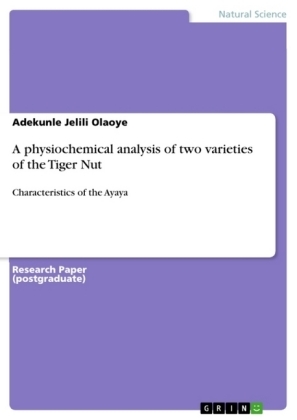
A physiochemical analysis of two varieties of the Tiger Nut
Characteristics of the Ayaya
Seiten
2017
|
1. Auflage
GRIN Verlag
978-3-668-47437-6 (ISBN)
GRIN Verlag
978-3-668-47437-6 (ISBN)
- Titel nicht im Sortiment
- Artikel merken
Research Paper (postgraduate) from the year 2017 in the subject Chemistry - Analytical Chemistry, grade: 3.0, Ladoke Akintola University of Technology (Faculty of Pure and Applied Science), course: Chemistry, language: English, abstract: This study was based on the physico- chemical and proximate analysis of two varieties of the tiger nut (brown and yellow). Tiger nuts were obtained from Sabo market Osogbo, Osun state Nigeria. The result obtained showed that the specific gravity of the sample were 0.95 and 0.93 for yellow and brown tiger nut respectively, the refractive index of the sample were 1.510 and 1.488, the pH of the sample were 8.85 and 8.06 while viscosity of the sample were 97226.86 and 89377.14 for yellow and brown tiger nut respectively. The chemical properties of the sample showed that, the iodine value of the sample were 11.62 and 15.23, the acid value of the sample were 14.63 and 8.82, peroxide value of the sample were 3.4 and 2.2 while saponification value were 7.91 and 9.82 for yellow and brown tiger nut respectively. The result of proximate analysis showed that the percentage of moisture content were 4.80 and 4.00, the percentage crude protein of the sample were 8.07 and 7.30, percentage of crude fibre of the sample were 7.60 and 6.80, the percentage crude fat were 26.10 and 25.50, the percentage total ash of the sample were 2.03 and 2.00 while percentage carbohydrate of the sample were 51.40 and 54.40 for brown and yellow sample of tiger nut respectively. The tiger nut has the potentail to be a source of industrial materials.
Tiger nut is commonly known as earth almoud Chufa nut grass and Zulu nut. It is known in Nigeria as Ayaya in Hausa, Ofio or Imumu in Yoruba and Aki - hausa in Igbo where three varieties black, brown and yellow are cultivated. Among these only two varieties yellow and brown are readily available in the market. The yellow variety is preferred to all other varieties because of its attractive colour and fleshier body. The yellow variety also yield more milk upon extraction, contains fat and more protein and processes less anti-nutritional factors especially poly phenols.Tiger nut is an underutilized sedge of the family Cyperaceae, Kingdom Plantae, Order Poales, Genus Cyperus, which produces rhizomes from the base and tubers that are somewhat spherical. The Tiger nut with the binomial name cyperusesculentus is of several varieties. The plant of the tiger nut is from the family of Cyperaceae. This plant is cultivated for its small tuberous rhizome which is eaten raw or roasted, pressed for its juice to make beverage or milk, extracted of non-drying oil or used as hog feed.
Tiger nut is commonly known as earth almoud Chufa nut grass and Zulu nut. It is known in Nigeria as Ayaya in Hausa, Ofio or Imumu in Yoruba and Aki - hausa in Igbo where three varieties black, brown and yellow are cultivated. Among these only two varieties yellow and brown are readily available in the market. The yellow variety is preferred to all other varieties because of its attractive colour and fleshier body. The yellow variety also yield more milk upon extraction, contains fat and more protein and processes less anti-nutritional factors especially poly phenols.Tiger nut is an underutilized sedge of the family Cyperaceae, Kingdom Plantae, Order Poales, Genus Cyperus, which produces rhizomes from the base and tubers that are somewhat spherical. The Tiger nut with the binomial name cyperusesculentus is of several varieties. The plant of the tiger nut is from the family of Cyperaceae. This plant is cultivated for its small tuberous rhizome which is eaten raw or roasted, pressed for its juice to make beverage or milk, extracted of non-drying oil or used as hog feed.
| Erscheinungsdatum | 07.07.2017 |
|---|---|
| Sprache | englisch |
| Maße | 148 x 210 mm |
| Gewicht | 55 g |
| Themenwelt | Naturwissenschaften ► Chemie |
| Schlagworte | Chemie • crudeprotein • Crude protein • Lipids • proximate analysis • proximateanalysis • specific gravity • specificgravity • tigernut • Tiger Nut |
| ISBN-10 | 3-668-47437-0 / 3668474370 |
| ISBN-13 | 978-3-668-47437-6 / 9783668474376 |
| Zustand | Neuware |
| Haben Sie eine Frage zum Produkt? |
Mehr entdecken
aus dem Bereich
aus dem Bereich
Introduction for Scientists and Engineers
Buch | Softcover (2024)
Wiley-VCH (Verlag)
119,00 €


